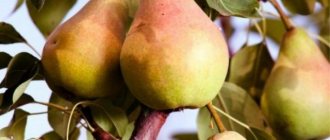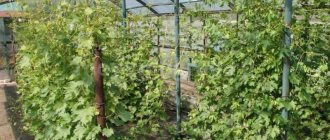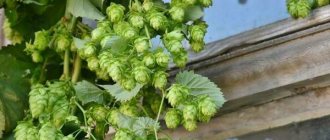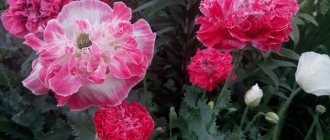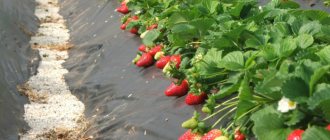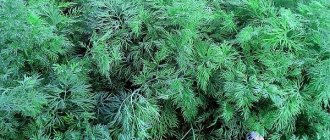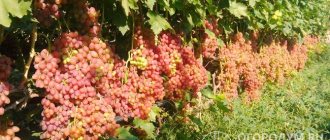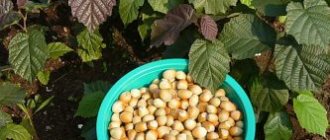Gardening » Citrus » Orange
0
1138
Article rating
Kira Stoletova
Oranges are fruit trees cultivated by humans for several thousand years. Now they are known in all countries of the world. Oranges grow outdoors in hot countries with tropical and subtropical climates.
How do oranges grow?
Description of the fruit
Orange is a hybrid that appeared by crossing a tangerine and a pomelo. The classification of the orange fruit is ambiguous - it is a fruit or a berry. Citrus is commonly considered a fruit, although the correct botanical name for the orange fruit is multilocular berry.
An evergreen woody plant, reaching a height of 12 m, living up to 150 years, belongs to the Rutaceae family. Some selectively bred varieties grow only up to 5-6 m. Ornamental trees grown in greenhouses do not exceed 2 m in height, and those grown indoors - 60-70 cm.
Appearance of an orange tree:
- leaves are rich green, fleshy, oval, with a sharp end and smooth edges, length - 12-15 cm;
- flowers are bisexual, with five oval petals, white or pinkish, with ten stamens, diameter - 5 cm;
- flowers are connected in clusters of 6 pieces;
- the fruit is an orange, inside there are 10-12 sections covered with translucent skin, each section is filled with elongated cellular cells with juice;
- the peel is dense, about 5 cm thick, the surface layer, called the zest, has an orange or red-orange color, underneath there is an albedo - a white soft layer;
- light small seeds are found in the pulp.
Orange trees bloom in March and April. The budding phase lasts almost a month, and the open flower lives for 2-3 days. Pollination occurs by cross-pollination, however, there are non-pollinated varieties - parthenocarpic hybrids, the pulp of which does not contain seeds.
General information about orange
The botanical name of this plant is orange tree (Citrus sinensis). This type of fruit tree belongs to the citrus genus (rutaceae family, orange subfamily).
Orange has been cultivated since ancient times. Its fruits are considered one of the most delicious and healthy and are therefore known throughout the world. We'll find out where oranges grow below. And their homeland is China.
This is a light-loving plant that grows on light and loose soils with a neutral environment.
The height of the tree reaches 12 meters, and its average lifespan is 75 years.
It is usually propagated by grafting, cuttings and seeds.
Where and how do oranges grow?
A tree sprouted from a seed begins to bear fruit when it reaches 8-10 years of age. And the harvest from low trees is harvested 3-4 seasons after planting.
Orange is a remontant crop, which is characterized by simultaneous flowering and fruit formation. The fruits reach maturity in late autumn, and harvesting begins in early winter.
Fruit tree with ripened fruits
It is difficult to grow an orange; the crop is extremely demanding in terms of moistening the roots and spraying the crown, does not tolerate lower temperatures, drying out of the soil, and does not tolerate replanting well. Citrus fruits ripen in tropical and subtropical regions. Leaders in orange exports:
- China;
- Egypt;
- Spain;
- Türkiye;
- Greece;
- Morocco;
- Portugal.
Where do oranges grow - in which country in the world?
Citrus fruits (including oranges) grow in subtropical and tropical conditions, where there are mild winters and hot summers, which is ideal for the growth of such a plant. But each region cultivates its own varieties of citrus fruits.
Oranges grow in many countries - from China to Europe. The very first plants were cultivated in China, from where they were brought by ships to the shores of Europe.
There are still countries that are leaders in the cultivation of these delicious exotic fruits. The most delicious sun oranges are grown in Turkey, Egypt, Spain, India, the USA and China. They are most often seen by buyers on the shelves.
They are also grown in Greece, Italy, Algeria, Portugal, Morocco, Africa, Japan, Australia, Brazil, etc.
Chemical composition and calorie content
100 g of orange pulp contains the following amount of BJU and other nutrients:
- 1 g protein;
- 0.2 g fat;
- 8 g carbohydrates;
- 2.2 g fiber;
- 1.3 g organic acids;
- 0.5 g of ash particles.
Citrus is a supplier of a large number of bioactive substances to the body. The minerals contained in the composition are:
- iron;
- calcium;
- potassium;
- phosphorus (the plant receives it mainly not from the soil, but from fungi living on the roots);
- sodium;
- iodine;
- zinc;
- magnesium.
Vitamins in orange:
- ascorbic acid (vitamin C);
- retinol (A);
- group B – thiamine, riboflavin, pyridoxine, pantothenic, nicotinic and folic acids.
The vitamins contained in citrus stimulate protein, lipid and carbohydrate metabolism, support the immune system and the functional state of the nervous system, strengthen blood vessels, normalize digestion, and improve the synthesis of hemoglobin and hormones.
The chemical composition of orange is rich and balanced; the orange fruit is saturated with substances that help prevent infectious, vascular and cancer diseases:
- phytoncides;
- pectins;
- flavonoids;
- replaceable and essential amino acids;
- saturated and polyunsaturated acids.
There are few calories in citrus, only 43-45 kcal per 100 grams of pulp. Since one average fruit weighs 80-90 g, then 1 piece. is 36-40 kcal. The calorie content of 1 orange without peel is more than with peel, 55-60 kcal. 100 g of dried zest contains 300 kcal. And the number of calories in fresh squeezed juice is 35 kcal.
Glycemic index of pulp is 35 units, juice – 45.
Description of the orange tree
The orange tree grows up to 12 m in height, popular cultivated rootstocks - up to 4-6 m. The dwarf species, which is grown at home in tubs, has a height of only 60-80 cm, greenhouse varieties - 2-2.5 m. The crown is compact, the branches have thorns up to 8-10 cm long. The trunk is covered with smooth brown bark.
According to the description, the orange tree grows for a long time and begins to bear fruit after 8-12 years if planted from a seed. Small seedlings produce a harvest within 3-4 years.
Root system
The roots of the orange plant do not have villi, which absorb moisture, minerals and organic substances from the soil. Instead, at the tips of the roots there are special caps on which saprophytic fungi reproduce. Through their mycelium, water and all the components necessary for nutrition flow to the tree. First of all, these are phosphorus compounds. In return, the mushrooms receive carbohydrates and amino acids.
Symbiosis increases plant productivity. At the same time, it becomes dependent on microorganisms. Mushrooms do not tolerate low temperatures or dry soil, so the plant bears fruit only in warm climates and requires watering and irrigation. When transplanting, it is easy to damage the roots and mycelium - this manipulation should be carried out carefully. The young tree is transferred to a new place with a lump of earth.
Leaves
The tree has dark green oval leaves
The leaf color is dark green, oval in shape, with a pointed tip. The petiole is short, with a winged appendage. Leaf area is 10-15 cm, the edges are smooth, wavy or with shallow notches. The surface is smooth, evenly covered with short fibers. The leaf blade is fleshy; in its thickness there are glands that produce essential oils with a specific odor.
The leaves on the tree change gradually. Approximately 25% falls in February and March, and the same amount is lost throughout the year. The average lifespan of one leaf is 2 years. Young leaves are responsible for photosynthesis; old leaves accumulate nutrients that are used for growth, the formation of flowers and fruits. The leaves tend to turn yellow in winter and then turn green again.
Orange varieties
The following types of oranges are grown:
- sour with bitterness (for cosmetic and pharmaceutical production);
- sweet (for eating).
Sweet citrus fruits are divided into 3 varieties:
- ordinary, the most common, oval-shaped with an orange or orange-yellow peel (popular varieties of oranges are Verna, Salustian, Gamlin);
- umbilical, richly sweet with a fleshy peel, with an underdeveloped second fruit in the apical part, similar to a navel (varieties Thomson, Kara-Kara, Washington);
- red (aka Sicilian), honey-sweet, with a reddish-orange skin and red, almost brown flesh, the color of which is due to the content of anthocyanins (popular varieties are Sanguinello, Moro, Tarocco).
Blood orange pulp
Fruit
The round shaped orange fruit is called bitter orange or hesperidium. It can be multi-seeded, multi-celled or seedless and is close in structure to a berry. The skin is a thick and soft structure up to 0.5 cm thick. On the surface it is smooth or slightly rough, covered with zest, and below it has a thin white layer (albedo).
In general, the orange peel makes up up to 42% of the total weight of the fruit, and its color can range from greenish and light yellow to reddish-orange.
Usually the fruit has a dense and elastic consistency. Its internal mass consists of nests or slices that separate from each other (up to 13 pieces), filled with very juicy and large cells of pulp with a sweet, sour-sweet or sour-bitter taste.
Most orange varieties have white seeds. There are also seedless plant species, the fruits of which are formed without pollination (parthenocarpic).
What are the benefits of orange?
Orange is an extremely beneficial fruit for the human body. He:
- Supports immunity, prevents the occurrence of infectious and colds.
- Thanks to its rich vitamin composition, it is useful for people suffering from hypovitaminosis.
- Cleanses the body of toxic accumulations.
- Helps eliminate defecation disorders.
- Improves well-being in case of endocrine pathologies.
- Supports liver function.
- Reduces the concentration of low-density cholesterol, prevents the development of atherosclerosis, stroke, and strengthens vascular walls. Stabilizes blood pressure.
- Orange is highly beneficial for a woman’s body; the product contains antioxidants that slow down aging and folic acid, which is necessary for the full development of the child in the womb.
- Citrus contains limonoids - bioactive compounds that prevent the spread of malignant cells.
- Minerals and B-group vitamins contained in oranges benefit the male body, improve sperm quality, and improve potency.
- Orange peel, saturated with essential oils, has antihistamine, antidiabetic, immunostimulating and anticancer healing properties, lowers blood pressure, heals the oral cavity, and removes phlegm from the bronchi.
- Orange juice is useful for the female body as a rejuvenating and toxin-removing agent. It is not only included in the diet, but also applied to the face as part of tightening, whitening and refreshing masks.
Beneficial features
Orange is rightfully considered a real vitamin bomb. The composition contains a lot of vitamins (C, B, PP, A) and microelements (magnesium, iron, potassium).
The product has many useful properties:
- has a tonic effect, gives a boost of vigor
- has antioxidant properties, rejuvenates the body
- cleanses the blood, prevents anemia
- prevents scurvy
- helps with constipation
- helps strengthen the immune system, used for ARVI and influenza
- has antimicrobial and anti-inflammatory effects
Orange is recommended for use for anemia, hypertension, and atherosclerosis. The juice is useful for weakness, lethargy and lack of appetite. The fruit is effective in preventing seasonal colds.
Orange should not be consumed if you have pathologies of the stomach and intestines, because its juice can be irritating.
Use with caution by diabetics due to the presence of sugars.
Now the fruit is widely used in various areas of life. The pulp is eaten fresh and made into jams, jellies and desserts.
Juice made from pulp is very popular. Jam, tinctures, and liqueurs are prepared from the peel. The product is used in the cosmetic and pharmacological industries.
Exporting countries annually supply about 70 million tons of fruit.
Let's watch a video about where oranges and other exotic fruits grow:
Oranges are fruit trees cultivated by humans for several thousand years. Now they are known in all countries of the world. Oranges grow outdoors in hot countries with tropical and subtropical climates.
How do oranges grow?
Harm and contraindications
You should not eat oranges for gastritis with high acidity of digestive juice and for peptic ulcers. Citrus fruits are irritants to the digestive tract, and the patient's condition may worsen.
Despite the low calorie content in one orange, you should not get carried away with eating the fruit. Citrus contains a fairly high concentration of sugars, so regular overeating can lead to diabetes. For the same reason, you should not eat an orange at night if you do not want to experience weight gain.
Since citrus juice is highly acidic, it is necessary to rinse your mouth with water after drinking it. This will avoid destruction of tooth enamel.
Citrus will bring not only benefits, but also harm to health if you eat more than 3 fruits per day. If you have hypovitaminosis, it is permissible to consume up to 6 fruits per day.
Compound
The pulp contains from 6 to 15% sugars, pectins, and citric acid. 100 grams of the edible part of the ripe fruit contains approximately 0.3 mg of iron, 197 mg of potassium, 13 mg of magnesium, 23 mg of phosphorus, 34 mg of calcium, 6 mg of silicon. It contains copper and iodine. Zinc, selenium, manganese, sulfur, and cobalt are present in small quantities.
Trees can still be found in the wild in the Himalayas. The age of some of them reaches 700 years.
Oranges are rich in vitamin C. One medium-sized fruit provides approximately half of the daily requirement for ascorbic acid. Also present are polyunsaturated fatty acids, vitamins B1, B2, B4, B5, B6, B9, E, H, PP, and vegetable protein. The zest is a source of natural essential oil. The zest contains sugars, pectins, and vitamin P. The chemical composition varies depending on the region, weather conditions, climate, variety and degree of ripeness.
Between the peel and the pulp there is a loose light mass - albedo. It is in it that the maximum amount of pectin is concentrated. The peel contains more than 60 different bioflavonoids. These substances have anti-inflammatory, antioxidant and antitumor properties.
How to peel an orange
The easiest and most convenient way to peel an orange:
- You need to properly clean the fruit by placing it on a hard horizontal surface. Turn it, pressing from above with your palm. This will make the fruit juicier and easier to peel.
- Use your fingernail to pick out the peel. It is advisable to do this near the top or stalk, where the skin does not fit so tightly to the pulp.
- Pick up the peel and carefully remove it with your fingers or a knife, being careful not to touch the flesh, otherwise splashes will fly.
If you need to peel an orange from the film, but keep the juice in the pulp, then do the following:
- Remove the top of the fruit with a knife.
- From the top to the stalk, cut off the peel in parts in a circle, capturing a little pulp. With this method of cleaning, the juice will be released slightly.
- The peeled fruit is placed so that it can be conveniently divided into slices. To cut an orange, first use a knife to separate the pulp from one side of each slice, then from the other. It turns out that the slices are cut without film and without loss of juice.
Origin of the orange
The name "Orange" comes from the Dutch (according to some versions - English) language. It translates as "Chinese apple." The birthplace of orange is China. This is the oldest fruit cultivated by people. According to historical information, it began to be grown in the Middle Kingdom as early as 2500 BC. e. But there is an opinion that orange citrus seeds came to China from India.
Orange trees were also grown in ancient Egypt, where the citrus fruit was used as a medicinal remedy. The fruit came to Greece from India after the campaigns of Alexander the Great, but did not become widespread. It was brought back to Europe by the Portuguese in the 15th century. It is not for nothing that in some languages the name sounds like “portogallo”, i.e. “Portuguese”. Fruits came to the Mediterranean countries earlier, from the Middle East, after Christ’s campaigns. Now this type of citrus fruit has become the most popular.
The orange is of hybrid origin, its ancestors being the tangerine and the pomelo. It remains unknown whether the crossing occurred naturally or artificially.
According to the botanical classification, the fruit belongs to the Rutaceae family, the Pomerantaceae subfamily, and the Citrus tribe. It is an evergreen tree that reaches a height of 10-12 m and can live up to 100-150 years.
Selection and storage of oranges
When choosing a product, pay attention to how it looks and smells and where it came from:
- The richer the citrus aroma, the more ripe the fruit.
- If the fruit is large, but its weight is suspiciously small, then the taste will not be good.
- The most delicious citrus fruits are Spanish, Moroccan, and North American. Egyptian and Turkish have average taste. And African and South American fruits are the most sour and are often unripe.
- Navel oranges are the most popular and have the sweetest taste.
- You should not buy citrus fruits whose peel is easily pressed. They won't be juicy.
Store oranges in the refrigerator, in the fruit and vegetable compartment. Fruits wrapped in paper or folded in cardboard packaging last up to 2 weeks. To extend the shelf life of citrus fruits, their peels can be treated with sunflower oil.
Fruits should be stored in the fruit and vegetable compartment of the refrigerator.
Do not store oranges next to other products. In this case, the fruit will quickly spoil and the food will absorb the citrus smell.
Conditions necessary for life
The orange tree is very thermophilic. It is completely unsuited for life in cold and frosty conditions. The tree does not tolerate large temperature changes; when the amplitude is more than 8 degrees, it sheds its leaves.
Also, the exotic plant is demanding of humidity; it feels great at 60-70%.
For citrus fruits, soil quality plays an important role. The roots require loose, nutrient-rich soil.
Southern fruits are sensitive to storage. For successful transportation, it is necessary to collect them unripe and wrap them in paper.
Use of fruits
Most often, citrus fruits are eaten fresh. But they can also be used in cooking to prepare desserts, sauces, alcoholic and non-alcoholic drinks, and hot dishes.
Oranges are used to make jam, preserves, candied fruits, smoothies, even citrus chips. Popular drinks are liqueurs, wine, tea with orange peels, compote. Hot pork and chicken dishes with orange sauce in the oven are very tasty. The zest is used to create medicines: tinctures, syrups. And the juice is added to homemade cleansing and rejuvenating face masks and hair products.
Delicious chips are made from the fruit
Orange is a fruit that can be enjoyed all year round. It is not only tasty and refreshing, but also brings great benefits to the body as a source of vitamins and bioactive substances. Citrus is used for dietary nutrition, preparation of cosmetics and medicines. The main thing is to take into account the rate of use and contraindications so as not to cause harm to the body.
Varieties and uses of oranges
Currently, two large species groups of citrus fruits are cultivated:
- bitter-sour;
- sweet.
Bitter-sour ones have a sour taste with a pronounced bitterness. They are used in cosmetology and for the manufacture of certain medicines. Sweet oranges, which are also divided into 2 groups, are suitable for food:
- light (ordinary and umbilical);
- red.
The main difference between these types is the shade of the pulp.
Ordinary light
The fruits are versatile in preparation.
Regular or oval light oranges are the most common group. They have light yellow juicy flesh with a sweet and sour taste. The peel is yellow-orange or yellow, thin, adherent to the pulp. The most popular varieties:
- Gamlin;
- Verna;
- Salustian.
Ordinary varieties are universal. They are eaten fresh and used for making juices, canned food, preserves and jams, and liqueurs. The skin is suitable for making candied fruits and essential oils. Oranges of this variety grow in countries such as Morocco, Spain, Greece, South Africa, China, India, and Italy. They are also found in Abkhazia, Georgia, Crimea, near Sochi.
Umbilical varieties Neville
The main feature of this group of varieties is the reduced second fruit at the top. Sometimes it has a pronounced indentation, reminiscent of a navel. There are no thorns on the tree branch, unlike other species. The peel is thick and easily separates from the pulp. The weight of ripe fruits is 200-250 g, the taste is sweet, with slight sourness and a pronounced citrus aroma. Main varieties:
- Washington;
- Late;
- Thomson;
- Navelina;
- Kara-Kara.
Navel oranges have grown in popularity in recent decades. This is due to its sweeter taste than other varieties. The application is universal, but in our area they are more often eaten fresh. Citrus fruits of these types are grown in the USA, Brazil, Morocco, Spain, Greece, and Italy.
Blood oranges
The name of orange varieties is associated with the red color of their pulp. Synonyms are king, bloody or Sicilian. The red tint is due to the presence of anthocyanin, which is rare for citrus fruits. The species arose due to a mutation that occurred naturally with the orange. In Mediterranean countries, the plant has been cultivated for more than 1000 years.
The trees are low-growing, with an elongated crown. Fruit ripening is longer than that of other varieties. They have a round shape and a dark orange or brown skin. The pulp is red, but if the fruits are not yet ripe, it has a variegated appearance. The flowering bush is pink-red. The taste is sweet, with notes of honey, and a pronounced citrus aroma. The harvest is late - from February to June. Main varieties:
- Moro;
- Sanguinello;
- Tarocco.
Red fruits are eaten fresh, juices, jams, and candied fruits are made from them. This variety grows in the USA (Florida, California), Italy, Spain, Morocco.
Use in medicine
When talking about the use of orange pulp and juice in medicine, they usually mean the mild laxative, diuretic and choleretic effect produced by the product, as well as an anti-sclerotic effect, accompanied by a decrease in the permeability of the walls of blood vessels and their strengthening. In addition, numerous medical studies have established a number of other beneficial properties of the product.
- Antioxidant action . Anthocyanins contained in oranges, working as antioxidants, reduce the risk of a number of age-related diseases, including cardiovascular diseases and cataracts. Among all the studied plants of the rutaceae family, it is the orange that has the most pronounced antioxidant properties. Among other things, this also prevents the development of hypoxia in cells during physical activity. Similar antioxidant properties are characteristic not only of the pulp, but also of the peel of this fruit.
- Suppression of the activity of a number of bacteria . The antibacterial function occurs due to the fact that orange juice is able to stimulate the activity of macrophages.
- Treatment of neurodegenerative diseases . A hot infusion of orange peels has demonstrated the ability to inhibit biturylcholinesterase and MAO. And this, in turn, opens up prospects for its use in the treatment of neurodegenerative diseases.
- Improvement in diabetes mellitus . In diabetes mellitus, an alcoholic extract of the crusts can prevent the development of nephropathies, as well as improve skin regeneration in diabetic patients.
- Effect on the cardiovascular system . Flavonoids from orange juice are useful in preventing heart and vascular diseases, as they have antioxidant, hypoglycemic and hypolipidemic effects. The juice also “stops” the inflammatory reaction occurring in the vascular system, caused by the consumption of fatty foods. The likely reason for this is a decrease in lipid peroxidation caused by the antioxidants in the juice.
- Decreased blood pressure . Orange juice, additionally enriched with a vitamin complex, can lower blood pressure.
- Also, the pulp of orange fruits is recommended in dietary nutrition programs for vitamin deficiencies and anemia.
Use in dietetics
There is a popular belief that orange “burns fat,” so you can quickly lose weight with its help. In fact, this mechanism is indirect and manifests itself through the action of a substance called “naringin”. As nutritionists explain, when naringin enters the liver of a well-fed person, a signal is triggered, telling the body that he is hungry and to replenish energy, he needs to start burning fat. However, the same nutritionists warn that this “orange weight loss” can only lead to tangible results if you eat several dozen fruits at once, which is both difficult and unsafe, like any abuse. However, some nutritionists are developing their own diets based on oranges.
For example, Margarita Koroleva, known in the media as a nutritionist of the “stars” (since Valeria, Anita Tsoi, Nikolai Baskov are seen among her clients), created a short-term “Orange Diet”, which allows you to reduce weight to 5% of the original. The weight loss program is designed for 2 (maximum 3) days. During this time, you can only eat oranges and the whites of boiled eggs, and meals should be taken every hour. This rhythm contains the idea of activating metabolic processes, which help to lose weight.
It is important that when we talk about orange juice in nutrition and medicine, we always mean freshly squeezed juice. If, for comparison, we take fresh juice, a store product in the form of reconstituted juice and nectar, then per 100 grams the most vitamin C will be in freshly squeezed juice (70.9 mg), and reconstituted juice will take second place (57.3 mg).
Nectar will be in third place with 53.2 mg of vitamin, but the gap from second place will be insignificant. The term "reconstituted" in relation to orange juice is applied to a product made from concentrated juice by dilution. Sometimes the juice is only pasteurized and delivered to the shelves in this form (without dilution from concentrate). In this case, the packaging will be marked with the following abbreviation: “NfC” and/or the full inscription “Not from Concentrate”. But even such juice always undergoes heat treatment. For the industrial production of juices, both expensive varieties rejected due to size and appearance, and special varieties with reduced consumer properties are used - those that are poorly cleaned, have a small size and unsightly appearance (for example, the very juicy variety Salustyan, actively cultivated in Valencia).
In other words, the juice itself is often made from the same oranges, which in the form of a whole fruit lie nearby on the counter. And dietary restrictions arise not so much because of the raw materials themselves, but because of the method of preparing store-bought juice, to which a lot of sugar is always added. According to this parameter, orange nectar is the most harmful of the juice options. It contains about 11.8 mg of sugar, reconstituted - about 11 mg, and freshly squeezed - 8.9 mg of sugar per 100 grams.
The history of the appearance of the “Chinese apple”
For the first time, a citrus plant with a dense orange peel and sweet and sour pulp is mentioned in the ancient chronicles of East Asia around 4000 BC. e. China is considered to be the birthplace of oranges, where 200 BC. e. began to grow orange trees in greenhouses. The first “oranges” that the Chinese tried were the bitter fruits of the wild orange tree; they were not eaten. The fragrant flowers of orange blossom became the basis of an essence called “bergamot,” and the zest of the fruit began to be used as a tonic. This variety of wild citrus later “shared” genetic characteristics with the traditional southern crop, the fruits of which are known to us.
The modern orange is the result of Chinese breeding, which involved crossing pomelo and mandarin, and is not found in the wild. The first edible oranges began to be grown in the gardens of Chinese aristocrats. Perhaps that is why the citrus hybrid is named by the Dutch word “appelsien”, which means “Chinese apple”. Later, the culture was brought to the Mediterranean countries, Egypt and North Africa.
The Europeans who first tasted this amazing tropical fruit were the soldiers of Alexander the Great. In Europe, the first orange trees brought by Portuguese sailors were planted in the middle of the 16th century. Citrus fruits came to the Russian Empire in the 17th century and became an exquisite delicacy for noble people. At the beginning of the 18th century, oranges grew in Georgia (Batumi region), and in the 19th century they began to be cultivated in Sochi.
Oranges grow in different parts of the world
In ancient times, orange juice was considered an antidote to almost any poison and served as a detergent, dealing with grease and dirt.
Use in cosmetologists
The benefits of home use of face masks made from grated zest have been indirectly confirmed in the research works of cosmetologists. According to scientists, orange peel can prevent oxidative stress and prevent inflammatory reactions in skin cells caused by exposure to ultraviolet radiation. Only for this, the isolated substances must be correctly combined with other ingredients in the cream. Cosmetic benefits have also been found in orange juice. It turned out that in it the processes of yeast fermentation not only do not reduce the content of biologically active substances, but, on the contrary, increase the content of flavonones, carotenoids and melatonin. Hesperidin in orange juice can inhibit trypsin and the enzyme tyrosinase, and also promote the formation of melanin in the skin. Thanks to the abundance of vitamins and carotenoids, drinking orange juice reduces the harmful effects that alcohol consumption has on skin cells.
Conditions of detention
Caring for indoor orange:
- Lighting. Indoor orange is grown in warm conditions, so a good place for growing it is a south window, which provides an abundance of ultraviolet sunlight. In the summer, the crop is placed in a place where there is access to open air, but there is no wind. Orange trees at home with a lack of solar radiation bear sour citrus fruits. In winter, provide artificial lighting to extend daylight hours.
- Temperature. The orange tree is cold-hardy, but produces a few sour oranges at low temperatures, so it is important to maintain a relatively high temperature.
- Humidity. The optimal humidity level in the apartment should be at least 40%. If it is lower, then the orange tree will inevitably shed its leaves and die. During the heating season, do not allow the air to become dry. To combat it, a bowl with moistened moss or expanded clay is installed next to the home orange tree. Excess moisture provokes rotting of the root system.
Fertilizers and watering
Don't let the soil dry out
Once every two weeks, indoor oranges need to be fed by adding fertilizer to the soil.
Nitrogen stimulates the vegetative growth of the tree and the formation of fruits. Phosphorus has a positive effect on orange yield. Potassium improves the quality of citrus fruits and increases the winter hardiness of the plant. Calcium is responsible for vegetative and generative growth. It is extremely important to fertilize the substrate with these components.
Other substances are also used for feeding: ash at the rate of 1 tsp/1 liter of water, crushed weeds, dry tea leaves or coffee grounds, sugar at the rate of 1 tsp/1 tbsp. water, eggshell powder, and aquarium water.
Watering the plant is carried out as the surface layer of the earth dries; it is contraindicated to allow it to become dry. Before watering, the water must be left to stand for at least a day, because... Watering an orange with water containing chlorine is extremely harmful.
Features of grafting
A variety of species are grafted onto one citrus crop at the same time: oranges, lemons, tangerines, grapefruits, etc. A small shoot of any orange tree is used as a scion. It is important to cut the scion earlier to have a better chance of successful fusion. You can store the branch in the refrigerator for a long time by wrapping the lower tip in wet cloth and placing the scion in a plastic bag.
The following is important for vaccination:
- the diameter of the scion and rootstock must match;
- the grafting procedure with cuttings is carried out quickly;
- All cuts are made with sharp instruments.
The most convenient method is copulation, in which the rootstock and scion are connected, wrapped tightly with a special tape, then a plastic bag is put on the plant, which is tied at the bottom. The grafted orange is placed in a lighted and warm place; before growing, the bag is not removed for about 3 weeks.
Tree pruning
The indoor orange is pruned when it is actively growing, so that it then bears fruit abundantly. Without pruning the branches, the crop looks unkempt and blooms poorly, so it is important to care for citrus.
During the flowering period, the tree does not need pruning; only remove excess growth.
How to grow a TREE FROM A BONE. Orange. How to grow an orange at home? How to grow an orange tree at home?
How to choose oranges?
From a huge assortment, you want to choose the sweetest and juiciest fruits. To find a real treasure on the counter, you need to remember some tricks:
- The heavier the fruit, the juicier it is. Of two identical in size, it is better to choose the one that weighs more.
- Large does not mean sweet. Small fruits have a brighter and more delicate taste.
- The most delicious are those that are recently harvested. From January to April, fruits contain the maximum amount of useful elements.
- The color should be bright and uniform. There should be no dents or defects on the surface.
- The fruit should not be too soft or hard to the touch.
- An important criterion is the presence of a subtle pleasant aroma.
- Thick-skinned fruits are easier to peel, but they are less sweet.
- It is preferable to buy citrus fruits with a smooth surface. Fruits with large pores tend to be less juicy.
The fruits quickly deteriorate and require careful transportation and careful storage. They are picked unripe, placed in boxes and transported to the consumer.
Before use, fruits are washed, peeled, cut into slices, circles or divided into slices. The seeds are removed and the white shell is separated. It is important not only to choose the right one, but also to know how to peel an orange. The simplest way is this:
- use a knife to cut off the top in the area of the stalk, without affecting the lobules;
- exactly the same incision is made on the opposite side;
- The remaining crust is divided into slices with a knife, which are carefully removed.
How to peel an orange
Another convenient method consists of the following steps:
- make a circular cut in the middle,
- take a dessert spoon and carefully use it to separate the top layer over the entire surface.
How to grow an orange tree at home and plant care
Orange is very demanding in terms of growing conditions; it is a rather fastidious plant, and without sufficient experience, it is not so easy to get it to bear fruit in a room.
There are relatively few indoor varieties of orange, but they all produce wonderful fruits, varied in flavor, color and size. The most common and well-proven variety is the old, good variety Washington Navy, brought to Russia at the end of the 19th century from California. It belongs to the so-called “umbilical” oranges. Navel oranges are usually the largest and sweetest. On the lower part of the fruit they have traces of a second undeveloped fruit slightly protruding from the peel.
When growing an orange at home, a novice citrus grower should keep in mind that, having sowed a seed of any variety and grown a fruit-bearing tree from it, he will have to wait a very long time for the harvest - most often 10-15 years. The resulting fruits will most likely be of low quality, because in this case, varietal characteristics, as a rule, are not inherited. Therefore, seed propagation of orange is not recommended.
Caring for a homemade orange is not much different from caring for a traditional lemon. But orange is more cold-resistant and light-loving. Only windows with a southern orientation are suitable for its maintenance - this is fundamentally important, since on the north side the tree develops more slowly and produces few fruits with a sour taste. Orange loves direct sunlight, especially during the period of fruit ripening - with sufficient heat and light, they become sweeter.
So, orange is a light-loving plant that requires warm (20–25 ° C) rooms. If there is not enough light in the apartment, it will develop poorly and grow poorly.
In summer, it is advisable to take the orange tree out into the open air - this will ensure better growth and development. But in the first days, especially at noon, it needs to be shaded with gauze or thin lutrasil so that the leaves do not suffer from sunburn.
In winter, the temperature should not be lower than 10–12 °C. In winter, when there is little light and daylight hours are short, when caring at home, indoor oranges need to be illuminated, increasing the length of the day to 10–12 hours. During this period, if possible, it is better to keep the orange at a lower air temperature, which will have a beneficial effect on spring flowering.
In winter, the orange is dormant, its growth processes are inhibited and, accordingly, it requires less water. Therefore, the intervals between watering for orange plants at home should be increased. From October to the end of February, the plant is fed with fertilizers no more than once every 1.5–2 months.
When caring for oranges at home, young plants should be replanted annually at the end of winter; adults - after 3-4 years, by transshipment. Substrate of turf and leaf soil, humus and sand (2:1:1:1).
An orange tree can be shaped to your liking, although without any intervention it often forms a rather beautiful crown on its own.
Story
The birthplace of oranges is considered to be Southeast Asia and China, where these trees were cultivated two and a half thousand years BC. e. It is assumed that the first fruit trees of this species were the result of crossing tangerines and pomelo. The orange came to Europe through Spain around 1100 and then, with the beginning of the conquest of the New World, it was “relocated” (introduced) to America. It is known that by 1579 orange trees were bearing fruit in St. Augustine, on the Atlantic coast of northeast Florida. Around the 1870s in the United States, oranges, which had previously been propagated by growing seeds, began to be cultivated using budding (eye grafting).
This made it possible to reduce the degree of variability of the offspring, achieve a more stable varietal identity, and with a targeted expansion of species diversity, this made it possible to use as rootstock those types of citrus fruits that were better adapted to local conditions: climate, soil, diseases. The USA still ranks second after Brazil in terms of the largest orange harvest and first in terms of juice production. China, Mexico, Egypt, Turkey, Pakistan, India, Spain, Italy, and Iran play a significant role in the cultivation and export of oranges. The fruits are also collected in industrial quantities in Greece and South Africa.
Nowadays, the location of orange plantations depends primarily on suitable climatic conditions. However, at the end of the 16th century, with the advent of fashion for oranges in the high society of France, a structure was constructed to preserve and grow heat-loving oranges “for beauty”, which received its name from the French word “orange”, which means “orange” in French, - greenhouse. Greenhouses gained popularity and began to decorate rich houses not only in the south of Europe, but also in more northern countries. In the Soviet Union, oranges began to appear relatively widely on shelves during the reign of Nikita Khrushchev.
Moreover, then mainly one was exported, the Israeli variety Jaffa, named after the old name of the port city, from which Tel Aviv later “grew.” The popular variety took root in other countries, but it was brought to the USSR exclusively from Israel, thanks to the “orange deal” under N. Khrushchev. Its essence was that the property located on Israeli territory, which once belonged to the Russian Empire and later passed to the USSR, was decided to be sold under Khrushchev. The transaction amount was about 4 million dollars, a significant part of which the Soviet Union received in the form of orange tranches. Today, some varieties, while maintaining their taste, have lost their economic importance for the economies of producing countries. This happened with the Jaffa variety, which was no longer exported due to its high cost. But it was replaced by many other varieties of orange, the total number of which in various sources varies from several tens to several hundred.
Application and meaning
The fruits are eaten raw or processed to produce drinks, jams, and nectars. They are added to salads, sauces and other dishes. Sweet and sour slices are a wonderful dessert and a useful decoration for cakes and other confectionery products. Delicious candied fruits are prepared from the peel and pulp. This oriental delicacy has a pleasant, slightly tart taste.
In southern Europe, the zest is used to make liqueurs. The most valuable oil is extracted from the skin, which has tonic and deodorizing properties, helps relieve spasms and fight depression. Essential oil - used as a flavoring agent in the manufacture of medicines, various food products and confectionery products.
Citrus fruits are available all year round. These are permanent inhabitants of the shelves of popular supermarkets, regardless of the weather or climate zone. Their price is no higher than apples, and you don’t have to deny yourself a healthy treat.
Orange jam
If the purchase turned out to be not very tasty, then you can make delicious jam from it. It's easy to make at home. This original dessert goes well with tea or morning coffee and will delight you with its delicate taste and aroma.
Orange jam with peel - recipe:
- Take 1 kg of ripe fruits, wash well, grind through a meat grinder along with the skins. If you come across any seeds, it is better to remove them so as not to spoil the taste with bitterness.
- Add a glass of water, the juice of 1 lemon and a kilogram of sugar.
- Pour the mixture into a wide bowl, put on fire, cook until the desired consistency is obtained. This usually takes about an hour. Then the mass should be cooled. If desired, it is not prohibited to add chopped nuts, cinnamon or honey to it.
Orange jam with peel
Pests of homemade orange
Beneficial features
The exceptional popularity of the orange is due not only to the excellent taste of its fruit, but also to its unique chemical composition with a high content of nutrients found in the pulp, juice, zest and seeds. The main advantage of orange is the increased content of vitamin C (50 mg per 100 g), because 150 g of orange satisfies a person’s daily need for ascorbic acid. Orange fruits have a general strengthening effect on the body and increase immunity.
Orange contains a number of vitamins and minerals necessary for the human body:
- Vitamins B, A, PP, E;
- Minerals (potassium, calcium, magnesium, phosphorus, iron, copper, zinc);
- Pectins;
- Phytoncides;
- Anthocyanins;
- Sugar;
- Citric and salicylic acid;
- Orange essential oil.
A balanced combination of beneficial substances allows the use of oranges in the complex treatment of a number of pathological conditions:
- obesity;
- colds and various viral diseases, high fever;
- anemia, anemia, weakness, loss of appetite;
- chronic constipation;
- atherosclerosis;
- hypertension;
- gout;
- liver diseases;
- scurvy;
- periodontal disease and bleeding gums;
- gastritis and low stomach acidity;
- vascular and heart diseases;
- urolithiasis disease;
- lead poisoning;
- increased nervous excitability.
In order not to lose essential oils, bioflavonoids and pectins, which are rich in zest and seeds, it is recommended to squeeze oranges whole for juice.
Orange leaves purify the air and saturate the room with phytoncides, which have a detrimental effect on various pathogenic bacteria. This property is one of the factors in favor of growing oranges at home.
Orange juice is not only a tasty treat and a refreshing drink. It can bring invaluable health benefits:
- Increases “good” cholesterol. A study conducted in the United States in 2000 showed that regular consumption of the drink improves blood lipid profile.
- Helps get rid of excess weight.
- Restores bone health.
- Reduces the inflammatory process.
- Gives a boost of energy, especially in winter.
It is believed that the drink has a destructive effect on tooth enamel, so it is recommended to drink it through a straw or rinse your mouth with clean water.
The drink normalizes digestion and stimulates appetite. It is recommended for decreased bile secretion, a tendency to constipation, and hypoacid gastritis. It contains a large amount of pectin substances, which improve intestinal motility, ensure timely emptying, reducing the absorption of harmful components.
The bright drink is rich in phytoncides, which eliminate inflammation, suppress the growth and development of bacteria, protozoa and microscopic fungi. These natural antibiotics help cope with colds, flu, and restore strength after an illness or surgery. The drink perfectly tones and lifts your spirits.
Making one of the healthiest natural drinks is not at all difficult. Anyone can do it. To do this you will need:
- take 5 ripe fruits, wash thoroughly;
- wipe dry;
- peel, grind in a blender;
- Dilute the resulting mass with a bottle of mineral water and strain through a fine sieve.
To grow an orange from a seed, it is important to obtain a fresh seed from the domestic orange variety of interest. Old, bruised, hard-crusted seeds will not produce the expected results in the form of a beautiful home-grown orange tree. But the citrus exotic is still far away: the orange seed should be prepared, planted, germinated and the best conditions for growth created.
The preparatory stage is important, since a well-treated seed is guaranteed to sprout. The seeds are prepared for planting as follows:
- Select seeds that are weighty, large, regularly shaped and without damage.
- Remove from the pulp and clean by placing under running water.
- Leave the bones in soft water for a day
Each orange seed is placed in a separate glass. Planted 1-3 copies guarantee the germination of a homemade orange tree. Use soil created for citrus fruits or mix turf soil, peat and sand (2:1:1). A simpler composition is also suitable: peat and turf soil (1:1).
The planting steps are as follows:
- We use a pot (any small container), making holes first and pouring a drainage layer on the bottom. Stagnant water is harmful to the fragile roots of a young tree.
- Pour in soil and compact lightly.
- We make a hole in the ground at a depth of 1-2 cm and place an orange seed.
- Cover with soil, water and place in a warm, shaded place to germinate.
- We create a moist greenhouse effect by covering the pot with film or the cut-off top of a plastic bottle.
- The first orange sprout appears a month later. When seedlings germinate, the container is moved closer to the rays of the sun.
As soon as the small orange tree has 2 true leaves, it is time to replant it. A container with a diameter of 8 to 10 cm and the composition of the soil mixture is suitable: garden soil, sand, peat, humus (2:1:1:1). The time to change “place of residence” is spring.
Orange does not like picking and experiences it extremely painfully, so the root system should be handled with extreme caution. Transplantation of an adult plant is carried out by transshipment with a lump of earth. The root collar cannot be buried; it remains on the surface.
An orange tree is transplanted once every 2-3 years, using pots with a large volume. Too large a container with wet soil causes root diseases and the home orange tree loses its visual appeal and dies. For an “old age” orange, after 10 years of growth, it is enough to remove and replace the surface layer of soil.
An orange tree grown from seed is a favorite treat for many pests. It is actively visited by aphids and spider mites; sometimes mealybugs, scale insects and false scale insects are found on it. In case of minor damage to the orange, folk remedies are used; in case of a serious attack, “chemistry” is used.
Diseases of homemade oranges usually occur due to improper care and are fungal in nature. These are root rot, gommosis, anthractosis, and powdery mildew. The fight is going on in three directions:
- restoration of proper care;
- removal of affected parts;
- fungicide treatment.
Sometimes a sooty fungus appears on the leaves in the form of a black coating. It does not harm the house plant and is easily removed with a swab dipped in water. If a marbled color appears on the leaves, this is a viral infection that cannot be treated.
Growing a homemade orange tree from a seed is the dream of any self-respecting gardener. And it is quite feasible. You just have to put in a little effort, add a little patience and apply the acquired knowledge about subtropical exotics in practice. And now a beautiful tree, hung with bright balls of fruit, decorates your home, adding bright summer notes to it.

